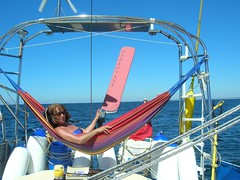 |
| Now this is what I call sailing! |
ROGER’S BLOG
We motored around the Basin D’Arcachon looking for somewhere to anchor for a trip ashore. Once again, all the anchorages were taken up with hundreds of moorings with small boats on them, the tide was quite strong 2 – 3 knots and there were motor boats and jet skis racing about everywhere. In the end, we tried to pick up a buoy, but were chased off by a French official. We tried somewhere else, and ended up with the buoy under the boat which then sliced the pick up buoy off. We gave up on the idea of going ashore in Arcachon and thought we’d anchor in the lagoon by the Dune de Pyla, which is a 103 foot sand dune 8 kilometres south of Arcachon and is the largest sand dune in Europe. It is spreading eastwards at about 4.5 metres a year and has already swallowed trees, a road junction and a hotel! According to the Pilot Book, there are four Eastern Cardinal Buoys marking the narrow channel. We got to the position where they were supposed to be and followed what we thought should be the channel, but when the depth sounder was reading 0.08 under the keel, and bearing in mind we were on a falling tide, we decided to turn tail and give up with this place altogether. We decided we really didn’t like Arcachon and wanted to get away as fast as possible.
By now it was 1 p.m. and we were on half tide, but the estuary was very flat as there was no wind, and visibility was excellent, so we set sail for St. Jean de Luz in the French Basque country. This would mean a 4 a.m. night arrival but would give us another 70 miles or so of ‘southing’ I am a trifle nervous in this south east sector of Biscay. With all my previous Biscay crossings, my instincts have led me to stay well out to the west of the continental shelf, so this is literally unknown territory. The landsman fears the sea, the sailor fears the land and a wimp like me fears both!
In any event, the passage from Arcachon to St. Jean de Luz was a delight. A westerly sea breeze during the day gave us a cruising chute and full main broad reach in glorious hot sun. At night, the sea breeze died and we motor-sailed on a smooth silver moonlit sea, with shooting stars, a firework display from Bayona 20 miles away and star spotting to keep us occupied.
However, we had noticed that the barometer had dropped 5 millibars in 6 hours – a sure sign of a coming deterioration. Most sailing schools tell you that a drop of 6 millibars in three hours will be followed by a Force 6 and one of 8 millibars in three hours be a Force 8. In my experience, this is true but of limited practical use as you have usually insufficient time to seek shelter. Of more value is the 4/5/6 rule which says that a drop of 4 or 5 millibars in a six hour period will be followed, albeit not immediately, by a significant deterioration.
I was perhaps musing on the significance of barometric pressure drops as we motored towards the anchorage in the bay of St. Jean de Luz at 4.00 a.m., because I didn’t see the lobster pot buoy flag sliding down the side of the boat. Sheila spotted it and we immediately put the engine in neutral and peered behind into the dark to see whether the buoy had floated free. Although we had not seen the buoy, we tentatively engaged forward gear and the boat responded. We are equipped with a razor sharp rope cutter on the prop shaft and I just hoped that it had done its job. We dropped anchor, I put the engine in reverse to stop the boat and ‘bang’ – the engine stopped – we had a wrap!
Given the lack of wind, we decided to drop the 16 kilo delta anchor and 50 metres of 10mm chain and wait for daylight to clear the pot buoy line, and hoped that we would not drag, as presumably we were also still anchored to the pot buoy.
No comments:
Post a Comment